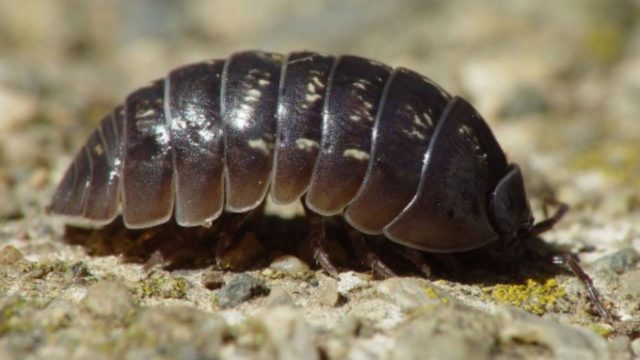“Rollie pollies” or pill bugs are tiny bugs that hide in your garden and curl up into a ball when they sense danger. Not a lot is known about these tiny creatures, but one thing is sure: they are no threat to you and can even have a great impact on the environment.
In fact, “rollie pollies” are not even bugs but crustaceans which makes them more like crabs than bugs. After years of evolution, they have accustomed themselves to living on land, and mostly in moist areas as they get their nutrients directly from the ground. They use their gills for breathing and their habit of rolling was developed to protect the moisture on these.
If you are thinking of getting rid of pill bugs from your garden, think twice as they are doing you a huge favor by being there. First, they feed on plant debris and second, they also consume metal which means that they extract it from the soil and leave it clean. Pill bugs consume a lot of lead, cadmium, arsenic, copper, and zinc and this makes them highly resistant to severe environments and conditions.
Their most important contribution to your garden is leaving the soil clean and healthy.
So, to keep them close to you and your outdoor space, you must create a welcoming space for them.
You can do this by adding organic matter to your soil, as this will keep them occupied and focused on protecting your garden from harmful elements.
















And where does this said metsls go after they die ?
Said metals go up the food chain. And guess who is at the top of that.
We always called these potato bugs. Wonder why?
Dunno either. Potato bugs are something completely different.
I’ve always just called them wood lice.
I never knew anything about them I always thought of them as a pest.
How do you spell ‘roly-polies’?
This was so very interesting. I enjoyed this article very much.
This article fails to address the obvious question, which is: what becomes of the various metals after the pill bugs eat them? Do they return to the soil when a pill bug dies? Or are they concentrated in the bodies of predators higher up the food chain? How do you reason that either of these possibilities is a net benefit to the environment?
I found the article VERY informative.
When I was a little girl we called them rollie-pollies. It fascinated me how they would roll-up into tiny little balls. I never knew any of what this article shared and I appreciate having the knowledge.
You can “always” Google for more information and answers.
My totally uneducated guess would be the heavy metals accumulate in the creature’s carapace, and are not digested by the robins and sparrows eating the pill bugs, but instead are excreted elsewhere, making the HMs an SEP…
As anyone will tell you from the Guildford area these are called Cheesybobs
How can they be edible if they consume heavy metals themselves? Sorry for my ignorance, just asking!
We called them pill bugs.
Very interesting article .! So where do the heavy metals go?????
Interesting used to call them gramner does!
Not crustaceans, but isopods. They have relatively enormous ocean-dwelling relatives–the size of a smallish watermelon–but all are harmless to us.
Yeah, but they also eat my plants
Where is the reference to the study (journal article)?
If course some of the meals degrade back in too the soil. But they have been posteriorly transformed but going through the digestive process. And sometimes they are carried away by bus or other carnivores. Nature works.
Do they process the metals or somehow metabolize it? I know that they have blue blood, which indicates something other than Iron plays a role in their metabolism (I can’t remember what causes that coloration, though.) The thing is, if you have metal contamination in your garden, you’ve got a serious environmental problem, and little isopods like these will probably have a negligible effect, despite their ability to consume toxic materials. (They’ll eat anything, including their dead compatriots.) They’re mainly compost feeders, and are gaining popularity as super-low-maintenance pets. In Denmark, they’re called “bench biters” for some odd reason.
Well, probably the mentioned metals in their bodies cannot find the way to our potatoes. As to the predators, I believe they can deal with the small amount of heavy metals (eagles die from poisoning if they eat buckshot, but it takes a lot of lead to poison such a bird) The predators who eat these little things may be as immune as rolli pollies.
Are they leaving the soil ” clean and healthy” as the article states or are they leaving the soil ” sterile?” After all, to grow better crops don’t we add micro minerals such as copper, calcium, zinc etc?.
Another article says the toxins stay in their bodies and would return to the soil after they die.
I know that heavy-metal resistant microorganisms, such as certain bacteria and yeasts, are able to detoxify by forming metal sulphides. As these compounds are extremely insoluble, toxic heavy metals are effectively locked away. Many metal ore deposits are sulphides, which is why they persist for geological periods. Maybe woodlice, the name I’ve always know for these crustaceans, use the same trick, as I can’t see them being inherently resistant. Or perhaps the ability is due to microorganisms in their gut, as anaerobic conditions are required for production of metal sulphides.
Their scientific name I’d isopods. They awe Crustaceans, relatives if crabs and lobsters. They are I think the only gro of crustaceans that live on land
Pill bugs are a type of millipede